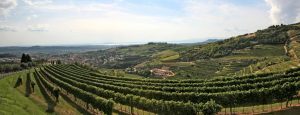Valpolicella is the most famous red wine district in north eastern Italy’s Veneto wine region. It’s not hard to understand why, given the easy drinking appeal of the regular red, Valpolicella Classico, coupled with the prestige of its powerful and intensely flavoured counterpart Amarone Della Valpolicella.
The valley also produces white wines, both dry and sweet, under the various Soave titles.
The Valpolicella red wine is typically made from three grape varieties: Corvina Veronese, Rondinella, and Molinara.
Most basic Valpolicellas (Classico) are light, fragrant table wines produced in a novello style, similar to Beaujolais nouveau and released only a few weeks after harvest. Valpolicella Classico is made from grapes grown in the original Valpolicella production zone. Valpolicella Classico Superiore is aged at least one year and has an alcohol content of at least 12 percent. Valpolicella Ripasso is a form of Valpolicella Superiore made with partially dried grape skins (Appassimento method) that have been left over from fermentation of Amarone or recioto.
The Valpolicella viticultural area covers a huge chunk of western Veneto, stretching north into the mountainous region above Verona for approximately ten miles, and east to west for more than twice that distance, linking Soave with Bardolino. The finest terroir is to be found in the north of the Classico zone, around the villages of Fumane, Marano and Negrar.
The hamlet of Gargagnago is also home to some of the region’s finest vines, although it is better known as the spiritual home of Garganega, the white grape behind the white wines of Soave and Gambellara. The hills here rise more than 600 meters (2000ft) into the fresh sub-alpine air, creating a patchwork of aspects facing in every direction and making the most of the northern Italian sunshine.

